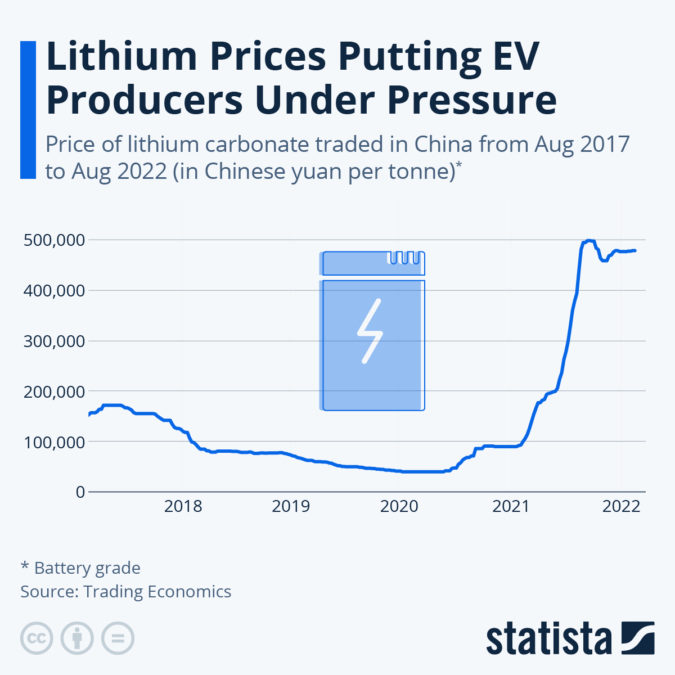Lithium Prices Putting EV Producers Under Pressure
With demand for electric vehicles on the rise, and production bans for petrol and diesel cars in some key markets on the horizon, one of the key metals required to fuel this mobility boom, has been surging in price lately.
As Statista’s Martin Armstrong shows in the chart below, based on price-tracking from Trading Economics, Lithium carbonate, essential for the production of the batteries used in EVs, has experienced a meteoric rise in cost over the last few months – being traded consistently above the 450,000 Chinese yuan/tonne mark since February.
You will find more infographics at Statista
With the current global supply chain issues and demand forecast to rise aggressively over the next few years, producers of electric vehicles are now under increasing pressure to maintain their pricing models, while also facing down significant hurdles to meet their production goals.
Worse still, analysts are predicting new lithium price highs around the corner, not the relief that the motor industry so desperately needs.
Even more troubling, as Autumn Spredemann writes at The Epoch Times, while increased domestic lithium production plays a crucial role in President Joe Biden’s green energy plan, lithium mining has quietly revealed itself to be a significant contributor to environmental pollution in the frantic rush to abandon fossil fuels.
Secretary of Energy Jennifer Granholm said Biden’s historic investment in electric battery production and recycling would give the United States “the jolt it needs to become more secure and less reliant on other nations,” in a May 2 press release.
Though some environmental experts believe that when it comes to lithium extraction, the end doesn’t justify the means.
“Our position is: mining is very destructive to the environment and communities. It needs to be approached judiciously,” John Hadder, director of Great Basin Resource Watch, told The Epoch Times.
In November 2021, United Nations Secretary-General Antonio Guterres remarked, “We’re digging our own graves” with mining, drilling, and burning during a world leader’s summit on climate change.
At the other end of the lithium debate are the spent electric batteries. Improperly disposed lithium batteries can be very unstable, causing landfill fires that can go on for years. The resultant toxic chemicals released into the air can also impact air quality and carbon emissions.
Vegreville explained batteries can be recycled, but lithium-ion units are especially dangerous due to fire hazards.
“One of the most ecologically friendly ways to dispose of a lithium-ion battery is to dismantle it,” he said.
Though the demand for lithium batteries is set to become a $116 billion industry by the year 2030, leaving some experts concerned that production may outstrip the industry’s ability to properly handle waste on the back end.
The U.S. Environmental Protection Agency admits special recycling and hazardous waste facilities are needed to deal with the influx of electric batteries. One standard electric car battery on average weighs over 1,000 pounds.
In other words, the recycling end will need to be a highly regulated, multi-million dollar industry in its own right to reduce pollution and fire hazards.
Moreover, Hadder says the current political demand for lithium could end with a push for more toxic, unsustainable projects in the long run. And while he supports a transition to renewable energy overall, the current gold rush mentality for lithium is anything but green.
“What we’re seeing now is a repeat of patterns and practices of the past,” Hadder said.
Tyler Durden
Sun, 08/21/2022 – 16:00

